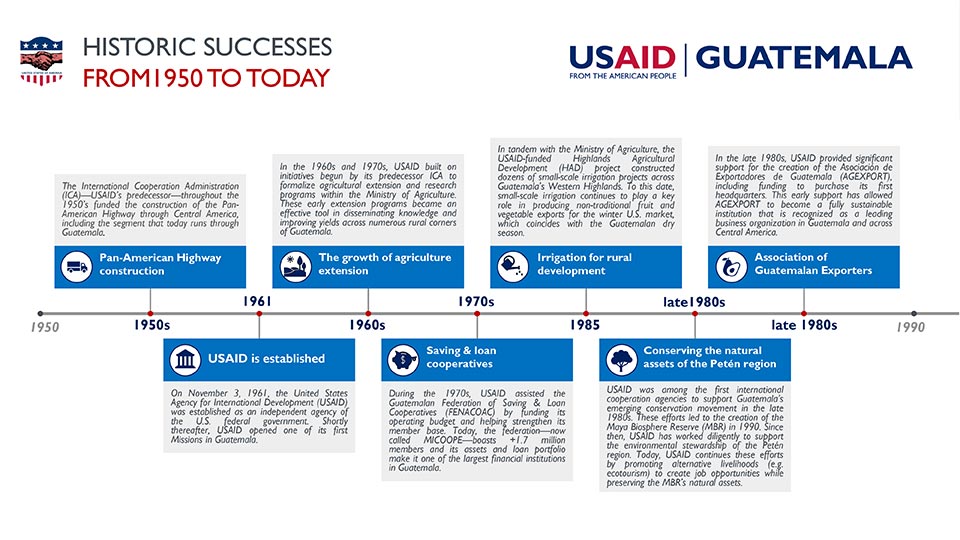Speeches Shim
1950s
Pan-American Highway Construction
The International Cooperation Administration (ICA)—USAID’s predecessor—throughout the 1950’s funded the construction of the Pan-American Highway through Central America, including the segment that today runs through Guatemala.
1961
USAID is Established
On November 3, 1961, the United States Agency for International Development (USAID) was established as an independent agency of the U.S. federal government. Shortly thereafter, USAID opened one of its first Missions in Guatemala.
1960s
The Growth of Agriculture Extension
In the 1960s and 1970s, USAID built on initiatives begun by its predecessor ICA to formalize agricultural extension and research programs within the Ministry of Agriculture. These early extension programs became an effective tool in disseminating knowledge and improving yields across numerous rural corners of Guatemala.
1970s
Saving & Loan Cooperatives
During the 1970s, USAID assisted the Guatemalan Federation of Saving & Loan Cooperatives (FENACOAC) by funding its operating budget and helping strengthen its member base. Today, the federation—now called MICOOPE—boasts more than 1.7 million members and its assets and loan portfolio make it one of the largest financial institutions in Guatemala.
1985
Irrigation for Rural Development
In tandem with the Ministry of Agriculture, the USAID-funded Highlands Agricultural Development (HAD) project constructed dozens of small-scale irrigation projects across Guatemala’s Western Highlands. To this date, small-scale irrigation continues to play a key role in producing non-traditional fruit and vegetable exports for the winter U.S. market, which coincides with the Guatemalan dry season.
Late 1980s
Conserving the Natural Assets of The Petén Region
USAID was among the first international cooperation agencies to support Guatemala’s emerging conservation movement in the late 1980s. These efforts led to the creation of the Maya Biosphere Reserve (MBR) in 1990. Since then, USAID has worked diligently to support the environmental stewardship of the Petén region. Today, USAID continues these efforts by promoting alternative livelihoods (e.g. ecotourism) to create job opportunities while preserving the MBR’s natural assets.
Association of Guatemalan Exporters
In the late 1980s, USAID provided significant support for the creation of the Asociación de Exportadores de Guatemala (AGEXPORT), including funding to purchase its first headquarters. This early support has allowed AGEXPORT to become a fully sustainable institution that is recognized as a leading business organization in Guatemala and across Central America.
1992
Advancing Girls’ Education
Since 1992, USAID has supported the Government of Guatemala in developing policies that advance gender equality in education. With support from USAID, the Ministry of Education has:
- Conducted gender studies,
- Provided scholarships for girls,
- Advocated for girl’s education at the community level, and
- Developed practical gender-sensitive education materials to provide training for administrators, technical officials, and teachers.
Early 1990s
Justice Sector Reforms & The Rule of Law
Beginning in the early 1990s, USAID assisted Guatemala’s justice sector in implementing much needed structural reforms. These efforts were oriented in the creation, approval, and implementation of a new criminal code and process—changing the country’s justice system to an accusatory system. Today, rule of law programming remains an important pillar of the work that USAID and its local partners carry out throughout Guatemala.
1996
Institutionalization of Bilingual Education
Soon after the 1996 Peace Accords, USAID began working with the Ministry of Education to institutionalize bilingual education across Guatemala’s indigenous communities. These early programs were key in helping breakdown local stigmas associated with learning indigenous languages. Today, they remain a powerful tool to empower indigenous youth with traditional knowledge and modern language skills to be competitive later in life.
1997
Partners in Peace Implementation
From 1997 to 2003, the U.S. Government supported Guatemala’s initiative to implement the Peace Accords. USAID’s Peace Program collaborated closely with several hundred international and Guatemalan organizations to advance Peace Accord commitments in the areas of demobilization, productive assets, modernization of the state, and human capacity building.
2006
Alliances for Indigenous Community Health
In 2006, USAID supported the establishment of the National Indigenous Women’s Alliance for Health, Nutrition, & Education to engage in advocacy, monitoring, and promoting policy dialogue to reduce maternal mortality rates among indigenous women. In 2013, USAID expanded this support to five local indigenous men’s advocacy networks for health, nutrition, and education with participation from 200 local organizations.
2009
Effective Administration for Criminal Courts
In 2009, USAID partnered with the Supreme Court of Guatemala to define a model to address the most sensitive and complex criminal cases and established the first High Impact Court (HIC). The sensitive cases that were unable to be tried in local courts could now be brought to Guatemala City and heard before the HIC—which provided additional security, reducing the possibility of intimidation and influence of justice sector officials.
2020
Governance, Prosperity, & Security
In collaboration with local partners, USAID continues its more than 55-year mission to implement projects to contend with the three primary drivers of migration from Guatemala:
- Lack of governance,
- Lack of economic opportunities, and
- Lack of citizen security.
By focalizing its programming on Governance, Prosperity, and Security efforts, USAID ensures that its funds are directed at meeting the holistic needs of Guatemalans.


Comment
Make a general inquiry or suggest an improvement.